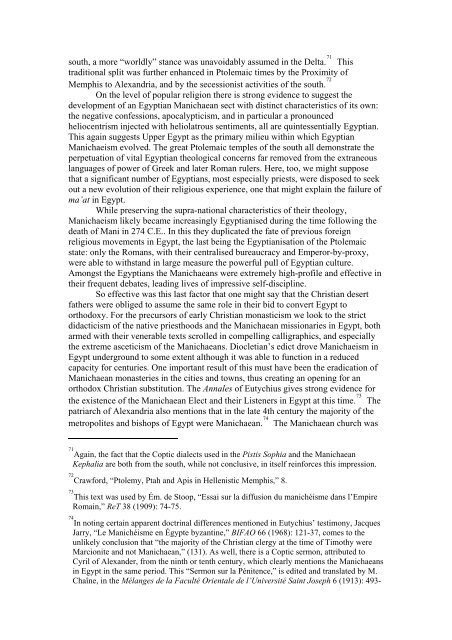THE EGYPTIAN FOUNDATIONS OF GNOSTIC THOUGHT
THE EGYPTIAN FOUNDATIONS OF GNOSTIC THOUGHT
THE EGYPTIAN FOUNDATIONS OF GNOSTIC THOUGHT
You also want an ePaper? Increase the reach of your titles
YUMPU automatically turns print PDFs into web optimized ePapers that Google loves.
south, a more “worldly” stance was unavoidably assumed in the Delta. 71<br />
This<br />
traditional split was further enhanced in Ptolemaic times by the Proximity of<br />
Memphis to Alexandria, and by the secessionist activities of the south. 72<br />
On the level of popular religion there is strong evidence to suggest the<br />
development of an Egyptian Manichaean sect with distinct characteristics of its own:<br />
the negative confessions, apocalypticism, and in particular a pronounced<br />
heliocentrism injected with heliolatrous sentiments, all are quintessentially Egyptian.<br />
This again suggests Upper Egypt as the primary milieu within which Egyptian<br />
Manichaeism evolved. The great Ptolemaic temples of the south all demonstrate the<br />
perpetuation of vital Egyptian theological concerns far removed from the extraneous<br />
languages of power of Greek and later Roman rulers. Here, too, we might suppose<br />
that a significant number of Egyptians, most especially priests, were disposed to seek<br />
out a new evolution of their religious experience, one that might explain the failure of<br />
ma’at in Egypt.<br />
While preserving the supra-national characteristics of their theology,<br />
Manichaeism likely became increasingly Egyptianised during the time following the<br />
death of Mani in 274 C.E.. In this they duplicated the fate of previous foreign<br />
religious movements in Egypt, the last being the Egyptianisation of the Ptolemaic<br />
state: only the Romans, with their centralised bureaucracy and Emperor-by-proxy,<br />
were able to withstand in large measure the powerful pull of Egyptian culture.<br />
Amongst the Egyptians the Manichaeans were extremely high-profile and effective in<br />
their frequent debates, leading lives of impressive self-discipline.<br />
So effective was this last factor that one might say that the Christian desert<br />
fathers were obliged to assume the same role in their bid to convert Egypt to<br />
orthodoxy. For the precursors of early Christian monasticism we look to the strict<br />
didacticism of the native priesthoods and the Manichaean missionaries in Egypt, both<br />
armed with their venerable texts scrolled in compelling calligraphics, and especially<br />
the extreme asceticism of the Manichaeans. Diocletian’s edict drove Manichaeism in<br />
Egypt underground to some extent although it was able to function in a reduced<br />
capacity for centuries. One important result of this must have been the eradication of<br />
Manichaean monasteries in the cities and towns, thus creating an opening for an<br />
orthodox Christian substitution. The Annales of Eutychius gives strong evidence for<br />
the existence of the Manichaean Elect and their Listeners in Egypt at this time. 73<br />
The<br />
patriarch of Alexandria also mentions that in the late 4th century the majority of the<br />
metropolites and bishops of Egypt were Manichaean. 74<br />
The Manichaean church was<br />
71<br />
Again, the fact that the Coptic dialects used in the Pistis Sophia and the Manichaean<br />
Kephalia are both from the south, while not conclusive, in itself reinforces this impression.<br />
72<br />
Crawford, “Ptolemy, Ptah and Apis in Hellenistic Memphis,” 8.<br />
73<br />
This text was used by Ém. de Stoop, “Essai sur la diffusion du manichéisme dans l’Empire<br />
Romain,” ReT 38 (1909): 74-75.<br />
74<br />
In noting certain apparent doctrinal differences mentioned in Eutychius’ testimony, Jacques<br />
Jarry, “Le Manichéisme en Égypte byzantine,” BIFAO 66 (1968): 121-37, comes to the<br />
unlikely conclusion that “the majority of the Christian clergy at the time of Timothy were<br />
Marcionite and not Manichaean,” (131). As well, there is a Coptic sermon, attributed to<br />
Cyril of Alexander, from the ninth or tenth century, which clearly mentions the Manichaeans<br />
in Egypt in the same period. This “Sermon sur la Pénitence,” is edited and translated by M.<br />
Chaîne, in the Mélanges de la Faculté Orientale de l’Université Saint Joseph 6 (1913): 493-










